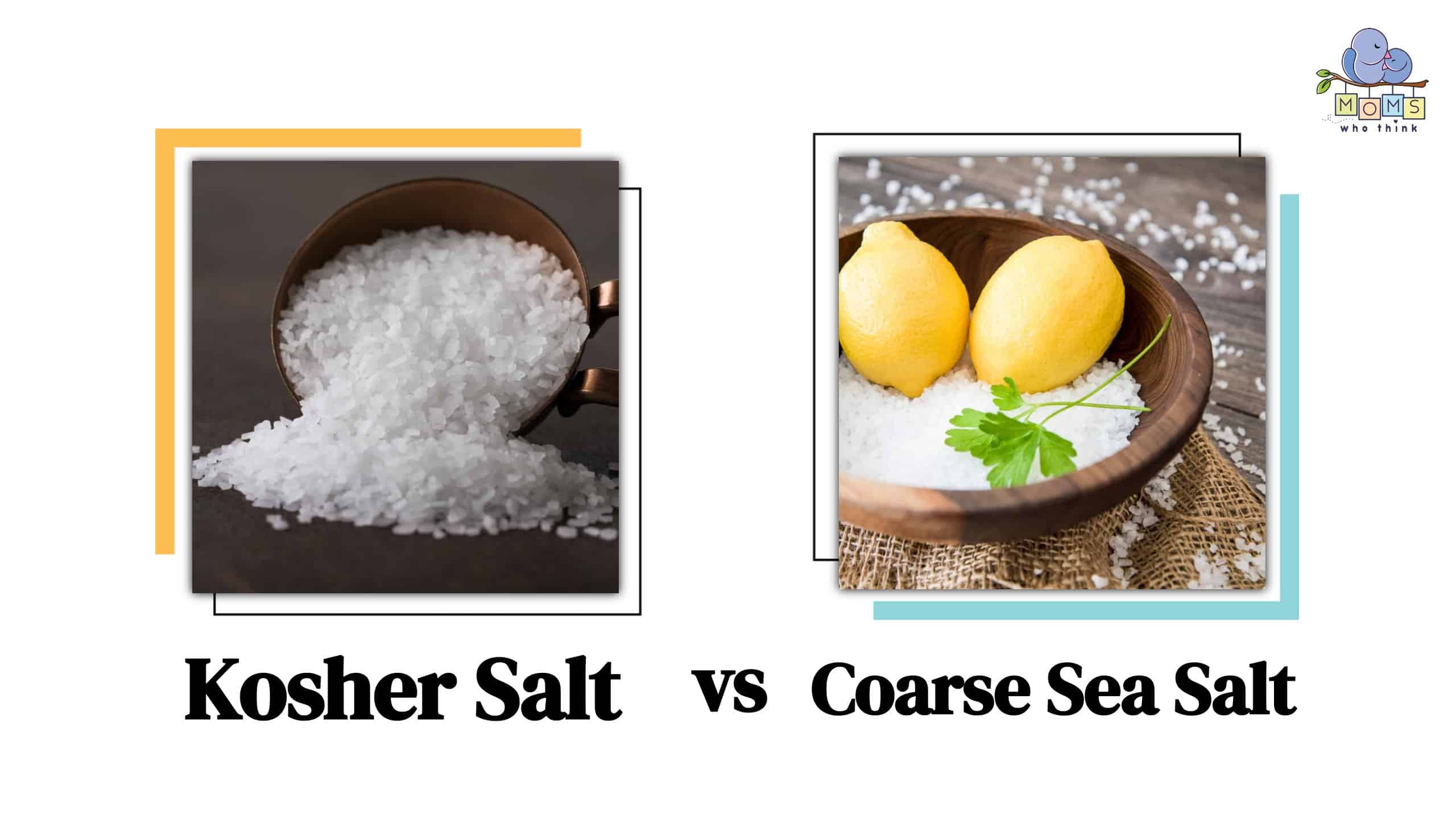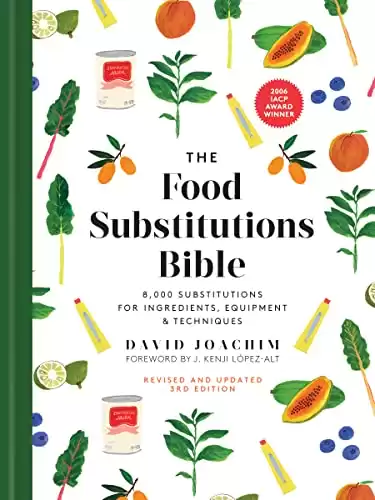When it comes to taste, kosher salt vs. coarse sea salt is very similar. Kosher salt is a type of coarse salt. Coarse sea salt is another type of coarse salt that is made by evaporating seawater. When it comes to cooking and baking, salt is an essential ingredient that brings out the flavors of other ingredients and helps balance the overall taste of a dish.
However, not all salt is created equal, and two popular types that are often compared are kosher salt and coarse sea salt. While both share some similarities, they also have distinct differences in texture, taste, and their uses that can affect the outcome of your dish. In this article, we'll explore the differences between kosher vs. coarse sea salt, their pros, and cons, and provide some fantastic tips on choosing and using them in your cooking and baking.
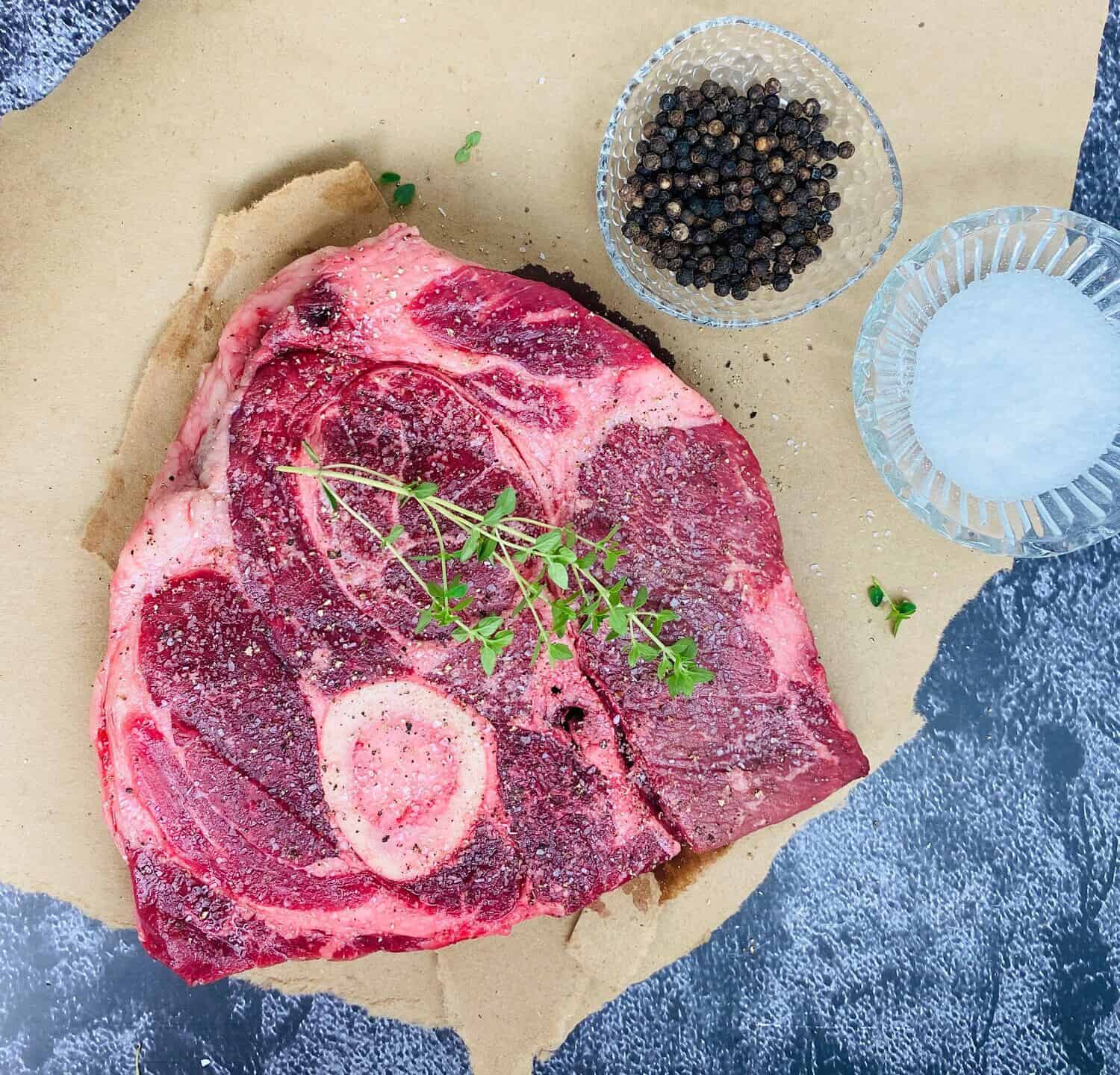
©rchat/Shutterstock.com
Understanding Kosher Salt
Kosher salt is a type of coarse salt that is popular among chefs and most home cooks. It is named “kosher” because it is commonly used in the preparation of kosher meats, which require the removal of all blood from the meat. Kosher salt has a larger grain size than table salt, making it easier to sprinkle and measure with your fingers.
How Kosher Salt is Made?
Kosher salt is made by compressing salt crystals into larger, irregularly shaped flakes. This gives it a bigger surface area and a more complex texture than regular table salt. It is also less refined than table salt and does not contain any added iodine or anti-caking agents.
- The must-have convenient reference guide for every home cook!
- Includes more than 8,000 substitutions for ingredients, cookware, and techniques.
- Save time and money on by avoiding trips to grab that "missing" ingredient you don't really need.
Common Uses for Kosher Salt
Kosher salt is a versatile ingredient that can be used in a variety of dishes. It is commonly used to season meats, vegetables, and soups. As it has a larger grain size, it is also useful for curing meats and drawing out excess moisture from vegetables.
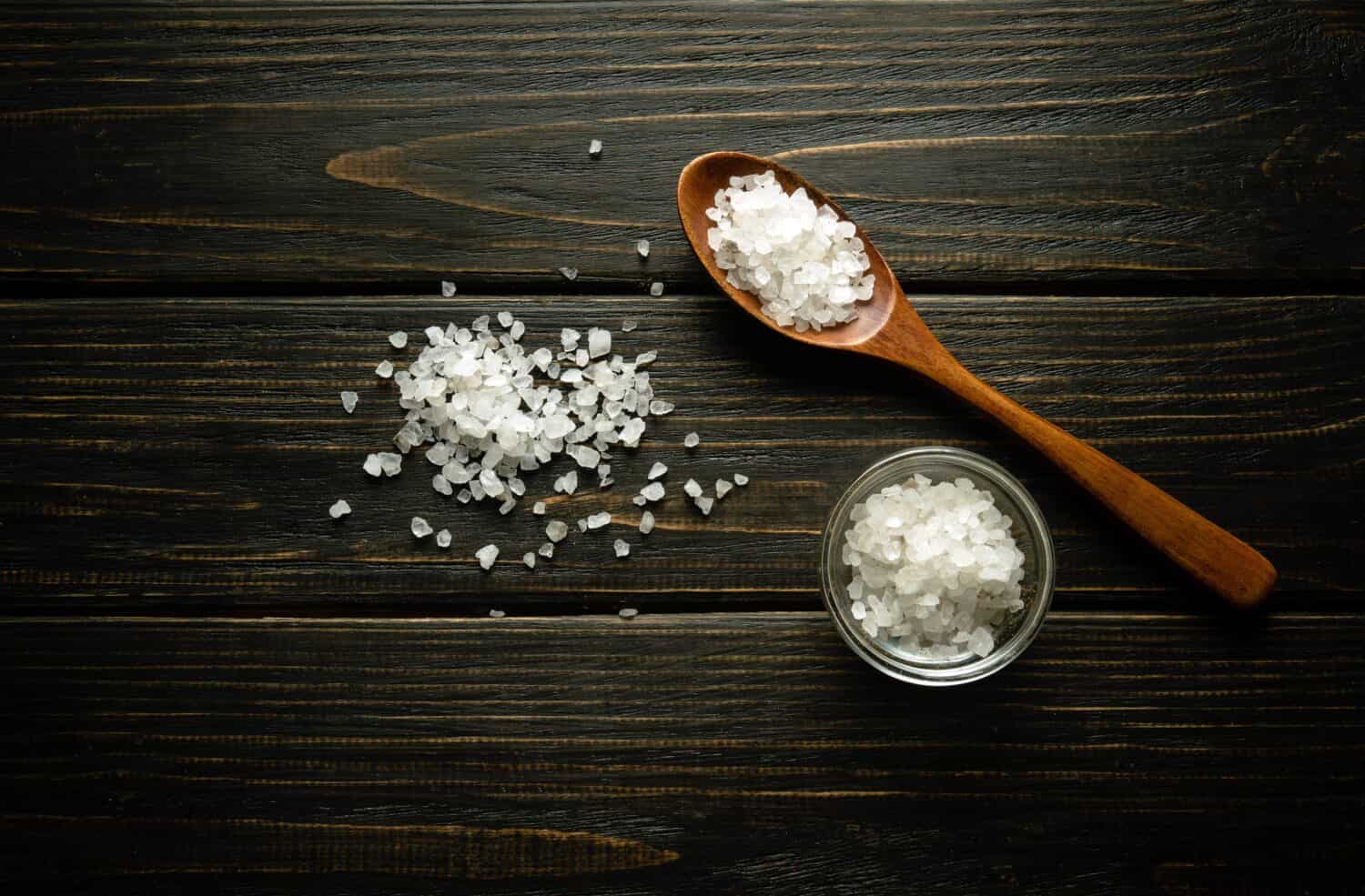
©VITALII BORKOVSKYI/Shutterstock.com
What is Coarse Sea Salt and How is it Used?
Coarse sea salt is a type of coarse salt that is made by evaporating seawater. It is also free from additives and has a larger grain size than table salt. Since it comes from the ocean, it has a slightly briny taste that can enhance the flavor of dishes.
How is Coarse Sea Salt Made?
Coarse sea salt is made by collecting seawater in large pans and allowing it to evaporate in the sun or through artificial heating. The salt crystals are then collected and cleaned to remove impurities.
Common Uses for Coarse Sea Salt
Coarse sea salt can be used in the same way as kosher salt. It is commonly used to season salads, vegetables, and meats. It can also be used as a finishing salt, sprinkled on dishes just before serving to add a crunchy texture and a burst of flavor.
Texture and Taste Differences
The main difference between kosher salt and coarse sea salt is their texture. Kosher salt has a more rectangular shape with a slightly rough texture. Coarse sea salt, on the other hand, has a more irregular shape with a crunchy texture.
Both kosher salt and coarse sea salt have a pure, salty flavor, but because it comes from the ocean, coarse sea salt sometimes also has a faintly saltwater flavor.
Benefits of Kosher Salt for Cooking and Baking
Kosher salt is often preferred by chefs and bakers because of its larger grain size, which makes it easier to pick up and sprinkle onto dishes. It also dissolves quickly, making it ideal for use in baking.
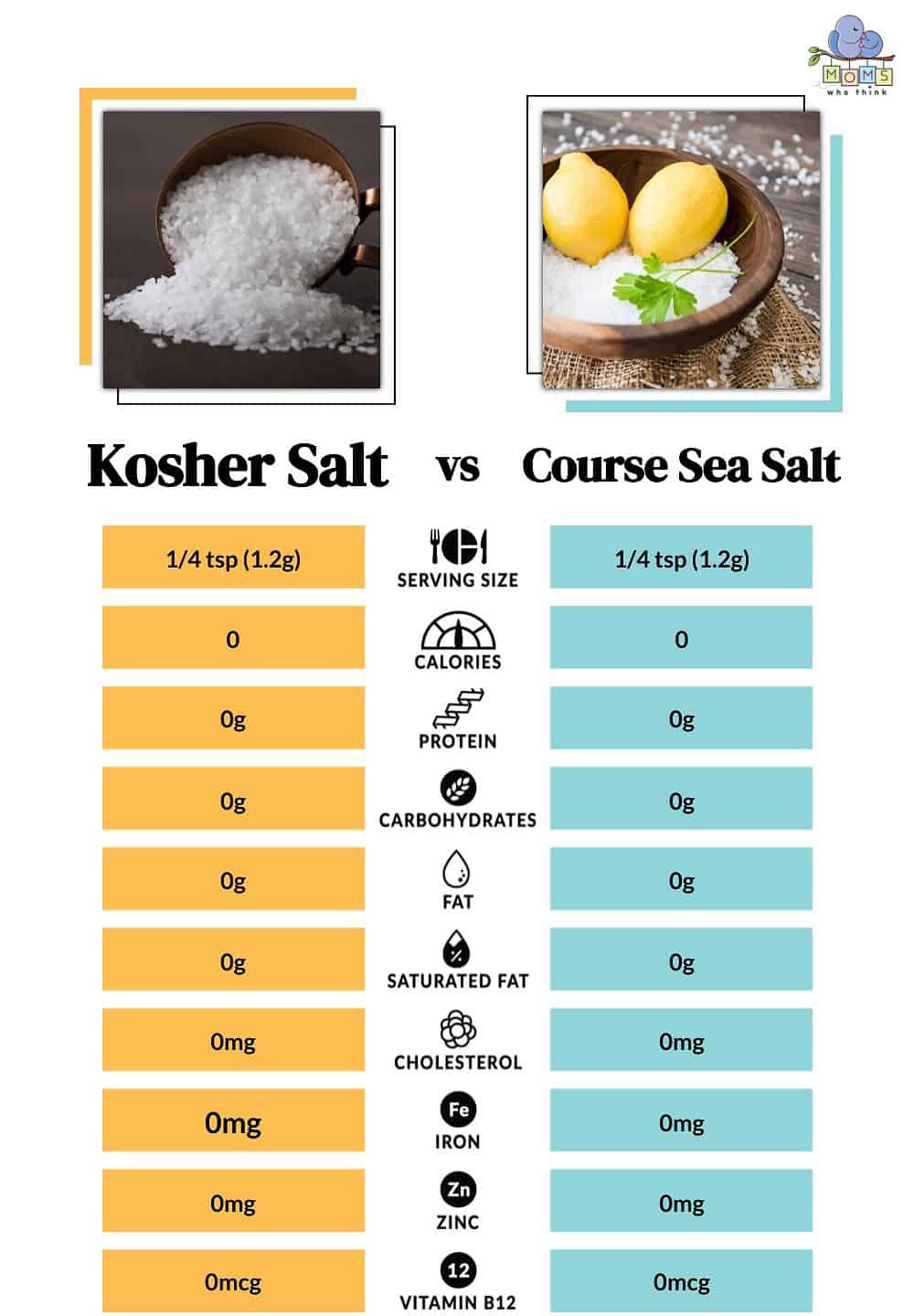
Recipes That Call for Kosher Salt
Many recipes call for kosher salt specifically because of its unique texture and taste. This includes recipes for brines, rubs, and marinades, as well as baked goods like bread and cookies. Morton Salt has a popular snack called Scrappy Munchies, a great side for parties. It is quick and easy to make and only takes about 10 minutes to prepare. The following ingredients are used:
- Unsalted butter
- Vanilla bean
- Soy sauce
- Brown sugar
- Honey
- Ground coffee
- Popped popcorn
- Crumbled potato chips
- Crushed pretzels
- Kosher salt
- Chocolate chips
If you do not have kosher salt on hand, you can substitute it with an equal amount of coarse sea salt. However, keep in mind that the taste and texture of the dish may be slightly different. It is also important to adjust the amount of salt used according to your taste preferences.
Recipes that Call for Coarse Sea Salt
Many recipes call specifically for coarse sea salt as a finishing salt, for roasted vegetables, salads, and grilled meats. It is also commonly used as a topping for baked goods, such as focaccia bread or pretzels.
Substituting Kosher Salt vs. Coarse Sea Salt in Recipes
If a recipe calls for coarse sea salt and you don't have any on hand, you can substitute kosher salt or another coarse salt variety. However, keep in mind that the flavor and texture of the dish may be slightly different. It's always best to follow the recipe as closely as possible for the best results.
Pros and Cons of Using Kosher Salt and Coarse Sea Salt
Both kosher salt and coarse sea salt have their pros and cons, depending on the type of dish you are preparing and your personal preferences.
- The must-have convenient reference guide for every home cook!
- Includes more than 8,000 substitutions for ingredients, cookware, and techniques.
- Save time and money on by avoiding trips to grab that "missing" ingredient you don't really need.
Kosher salt is a versatile salt that is perfect for everyday cooking. It dissolves quickly and evenly, making it ideal for seasoning soups, stews, and sauces. One downside of kosher salt is that it can be difficult to measure, as the crystal size can vary widely depending on the brand.
Coarse sea salt, on the other hand, has larger crystals that are perfect for finishing dishes. Its unique flavor and texture add more depth to dishes that other salts cannot replicate. However, coarse sea salt can be expensive and may be more difficult to find than other types of salt.
When to Use Kosher Salt
Use kosher salt in everyday cooking, such as seasoning meats, vegetables, and soups. Its even crystal size makes it easy to measure and control the amount of salt you add to a dish.
When to Use Coarse Sea Salt
You can use coarse sea salt to finish grilled meats, roasted vegetables, and salads. Its larger crystals add an extra burst of flavor and texture to finished dishes.
When to Use Table Salt
Table salt is best used for baking, as its fine crystals dissolve quickly and evenly. It is also commonly used in brines and pickling solutions.
Tips for Using Kosher Salt and Coarse Sea Salt in Your Cooking and Baking
Here are some tips for getting the most out of your kosher salt and coarse sea salt in your cooking and baking.
Measuring Salt Properly
When measuring kosher salt, use a kitchen scale for accuracy, as its crystal size can vary widely between different brands. For coarse sea salt, use your fingers to sprinkle it evenly over the dish, rather than using a salt shaker.
Storing Salt
Store salt in an airtight container in a cool, dry place to prevent clumping and ensure freshness. Have you ever noticed rice in the salt canister at a restaurant? Restaurants often put rice in salt canisters for a few reasons. The first is to absorb moisture, which helps keep the salt dry and prevents clumping. The second is to act as a desiccant, which helps to keep the salt fresher for longer. Finally, the rice absorbs odors, which helps keep the salt from smelling or tasting off. Rice is also a cheap and easy way to ensure the salt is kept fresh and ready for use.
Conclusion
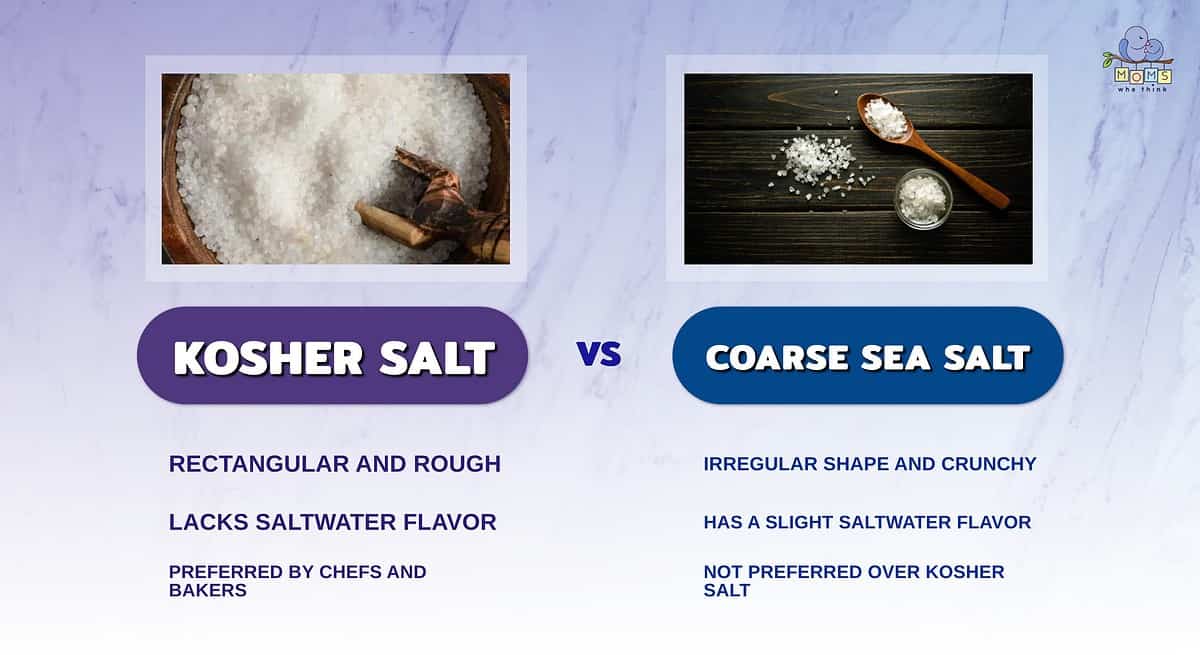
- Kosher salt has a defined, rectangular shape and rough texture, while coarse sea salt is irregular in shape and on the crunchy side. Kosher salt tends to be easier to incorporate into recipes.
- Since it comes from the sea, coarse sea salt can have a saltwater taste. If you just want pure saltiness in your dish, kosher salt is the way to go. You may not be able to tell the difference in taste with a small amount of coarse sea salt, but if a lot is used it may become more noticeable.
- Kosher salt is preferred by chefs and bakers because of how easily it can be incorporated into dishes.
In conclusion, the choice between kosher salt and coarse sea salt ultimately comes down to personal preference and the type of dish you're making. Both types of salt have unique characteristics that can enhance the flavors of your dishes in different ways. By understanding their differences and knowing how to use them properly, you can uplift your cooking and baking to new heights and create delicious meals that are sure to impress.
FAQ
Can kosher salt be used in place of coarse sea salt?
Yes, kosher salt can be used as a substitute for coarse sea salt in most recipes. However, keep in mind that you may need to adjust the amount of salt you use, as kosher salt has a different texture and weight compared to coarse sea salt.
Is one type of salt healthier than the other?
Both kosher salt and coarse sea salt are relatively equal in terms of nutritional value, as they both contain similar amounts of sodium. However, some coarse sea salt may contain trace amounts of additional minerals, depending on its source.
Can I use table salt instead of kosher salt vs. coarse sea salt?
You can use table salt in place of kosher salt or coarse sea salt. Nevertheless, table salt has a finer particle size, so you may need to adjust your usage accordingly. Additionally, table salt often contains additives like iodine, which can affect your dish's flavor.
Delicious Recipes to Try This Weekend
Print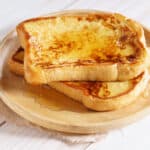
French Toast Casserole with Kosher Salt
- Yield: Serves 8 to 10 1x
Ingredients
- 1 1/2 loaves French bread (1 pound each)
- 2–3 tablespoons butter (for sides of the dish)
- 8 ounces cream cheese, room temperature
- 1 1/2 cups sugar, divided
- 2 tablespoons fresh orange juice
- 9 large eggs, divided
- cranberry syrup (recipe follows) or tart berry jam, or tart pie filling
- 1 cup heavy cream
- 1 1/2 cup milk
- 1 1/2 tablespoons vanilla extract
- 1 1/2 tablespoons orange flavoring
- 1/4 teaspoon kosher salt (less if table salt)
- 2 tablespoons grated orange rind
- Cranberry Syrup:
- 1 cup water
- 1/2 cup sugar
- 1 1/2 tablespoons cornstarch
- 1 teaspoon fresh lemon juice
- 2 cups (almost 10 ounces) fresh or frozen cranberries
Instructions
- Slice the crust from the bottom and sides of the bread leaving the soft top crust. Cut the bread into 1 inch cubes. Place 2/3 of the cubes in a buttered 9 by 13 inch dish.
- Beat the cream cheese, 1/4 cup of the sugar, 2 tablespoons orange juice and 1 of the eggs together on medium speed until blended. Pour over the bread cubes in the dish.
- Spoon dabs of cranberries from the cranberry syrup randomly on top of the cream cheese mixture making sure every piece will have some of the cranberries.
- Cover with the remaining cubes of bread.
- In a large bowl, mix the heavy cream, milk, 1/2 cup of the remaining sugar, vanilla, orange flavoring, salt and the remaining 8 eggs together on medium speed. Pour evenly over the bread making sure to spoon some of the mixture over the drier parts.
- Cover tightly and place in the refrigerator for at least one hour or overnight.
- Mix the last 3/4 cups sugar with the orange zest and place in the refrigerator until needed.
- When ready to bake, remove the french toast casserole from the refrigerator.
- Preheat the oven to 350 degrees F.
- Unwrap the dish and sprinkle the sugar and zest mixture evenly across the top.
- Bake for 50 to 60 minutes or until a toothpick inserted into the middle comes out clean. This will be a very soft, bread pudding type dish.
- Serve with warm Cranberry Syrup, maple syrup or any other berries used in the recipe.
- Directions for Cranberry Syrup:
- In a small sauce pan, whisk the water, sugar, cornstarch and lemon juice together until well blended and there are no lumps in the cornstarch. Add the cranberries and place over medium heat. Bring the mixture to a boil and remove from the heat as soon as the cranberries begin to burst. Pour into a heat proof dish to cool and thicken.
